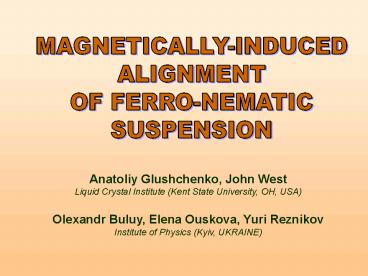MAGNETICALLYINDUCED PowerPoint PPT Presentation
1 / 11
Title: MAGNETICALLYINDUCED
1
MAGNETICALLY-INDUCED ALIGNMENT OF
FERRO-NEMATIC SUSPENSION
Anatoliy Glushchenko, John West Liquid Crystal
Institute (Kent State University, OH,
USA) Olexandr Buluy, Elena Ouskova, Yuri
Reznikov Institute of Physics (Kyiv, UKRAINE)
2
Magnetic Grains in Liquid Crystals
Liquid crystals can be oriented by large magnetic
fields of about 10 kGde Gennes, 1975. In 1970,
Brochard and de Gennes J.Phys. (Paris) proposed
a theory of magnetic suspensions in which liquid
crystals could be doped with small magnetic
grains. The mechanical coupling of magnetic
grains with the director n P.G. de Gennes, 1975
was responsible for the orientation process.
Following de Gennes prediction, many experiments
were performed with ferronematic and
ferrocholesteric liquid crystals. Thus, Chen and
Amer Phys.Rev.Lett., 1983 observed the
macroscopic collective behavior of nematic LC
doped with magnetic particles at low external
magnetic fields.
Liang and Chen Phys.Rev.A., 1989 investigated
coupling effects of magnetic field and electric
fields in ferronematics. In this work we report
a first observation of magnetically controlled LC
anchoring of Ferro-Nematic Suspension. The
suspension consists of sub-micron ferromagnetic
crystals in LC 5CB.
LC 5CB with Fe3O4 particles
3
Preparation of Ferro-Nematic Liquid Crystal
1. Milling of ferromagnetic material. Crystallized
particles of Fe3O4 (1 µm) were milled in a
surfactant surrounding (to prevent particles
coagulation) during 100 hours. 2. Fractionated
of the suspension in a liquid carrier. The
homogeneous fraction of the resulting suspension
is segregated in a column where particles of
different size were separated by the gravity
forces. 3. Producing of the suspension in a
liquid crystal. Obtained sub-micron particles of
Fe3O4 (1.5 wt ) covered with a surfactant were
added to the 5CB.
Mill
LC 5CB with Fe3O4 particles covered with a
surfactant
4
Orientation of suspension in Magnetic Field
1. Cells preparation. The symmetric cell
consists of two substrates were covered with ITO
which can not provide homogeneous planar
alignment of this type of LC in the whole cell.
The cell was filled with the suspension in
isotropic phase and cooled down. 2.
Magnetically induced orientation. The cell was
put into magnetic field H 1.25 kGs. In this way
homogeneous planar alignment of the LC along the
magnetic field was achieved. 3. Re-orientation
of the suspension at magnetic field
application. The cell with magnetically induced
planar alignment can be re-oriented at magnetic
field application (H gt 1 kGs) to a new direction.
5
Experimental Set-up and Procedure
1. Cells preparation. The combined cell was
filled with FNS suspension in isotropic phase and
cooled down. The reference substrate was covered
with rubbed polyimide, which provided a strong
planar alignment of LC.
2. Set-up.
3. Magnetically orientation liquid crystal. The
cell was put into magnetic field H gt 5kGs to get
a homogeneous planar alignment along rubbing
direction.
6
Dependence of the H-induced Director
Reorientation Angle on Magnetic Field
The cell is turned at 45o apart from the
direction of the magnetic field in the plane of
the cell.
After turning the cell there is a twist structure
due to reorientation of the director on the test
surface along vector H. The twist angle grows
with the increase of the field and achieves the
angle value 43o at H ? 3 kG . The value of
magnetic field required for the reorientation of
5CB with Fe3O4 was much smaller than in the cell
filled with pure 5CB.
7
Relaxation of Magnetically Induced Twist Angle
The switching off the magnetic field results in
the decrease of the magnetically induced twist
angle to the quasi-steady value about 6-7o during
15 min. In the cell filled with pure 5CB
relaxation of the magnetically induced twist
angle occurs in a few minutes to zero.
Fast relaxation of the magnetically induced twist
angle to small steady value says about an
extremely weak anchoring energy estimated as W ?
10-6 erg/cm2 and that magnetically induced easy
axis is caused by adsorption of the
ferro-particles on the test surface.
8
Stability of the Cells Response
9
Estimation
Application of magnetic field, which is not
sufficient to reorient the LC can reorient the
magnetic particles near the surface, and the
director of LC follows the reorientation of the
particles. Since the dipole of the
ferro-particles is parallel their long axes, the
final alignment of LC is parallel to H in the
symmetric cell. Since the homogeneous alignment
disappears in several days after
magneto-treatment, we suppose that the
magnetically-induced anchoring is very weak.
Small anchoring energy Wtest causes the
collective reorientation of the LC and
ferro-particles toward dref due a volume elastic
torque. It results in a drift of the easy axis,
etest , to the equilibrium state determined by
the torque balance on the tested substrate
f0 direction of the magnetically-induced easy
axis. K22? 410-7 dyne, f0430 and L50?m., Wtest
10-6 erg/cm2.
10
Conclusions
Action of the magnetic field applied to the cell
filled with ferro-nematic suspension resulted in
the orientation of the director on the test
surface along the magnetic vector H. The value
of magnetic field required for the orientation of
filled FNS was much smaller than in the cell
filled with pure 5CB. We conclude that
magnetic field induced an easy orientation axis
with an extremely weak anchoring energy W ? 10-6
erg/cm2 on a glass surface. We believe that the
magnetically-induced alignment of the ferro-LC
suspension is caused by adsorption of the
ferro-particles on the test surface and their
control with magnetic field. The developed
system is very promising for extra-sensitive
magnetically controlled LC devices and
information processing and storage.
11
Acknowledgement
This work was greatly supported by NSF ALCOM
grant DMR 89-20147 DARPA project No
444226 INTAS grant project No 99-00312.

